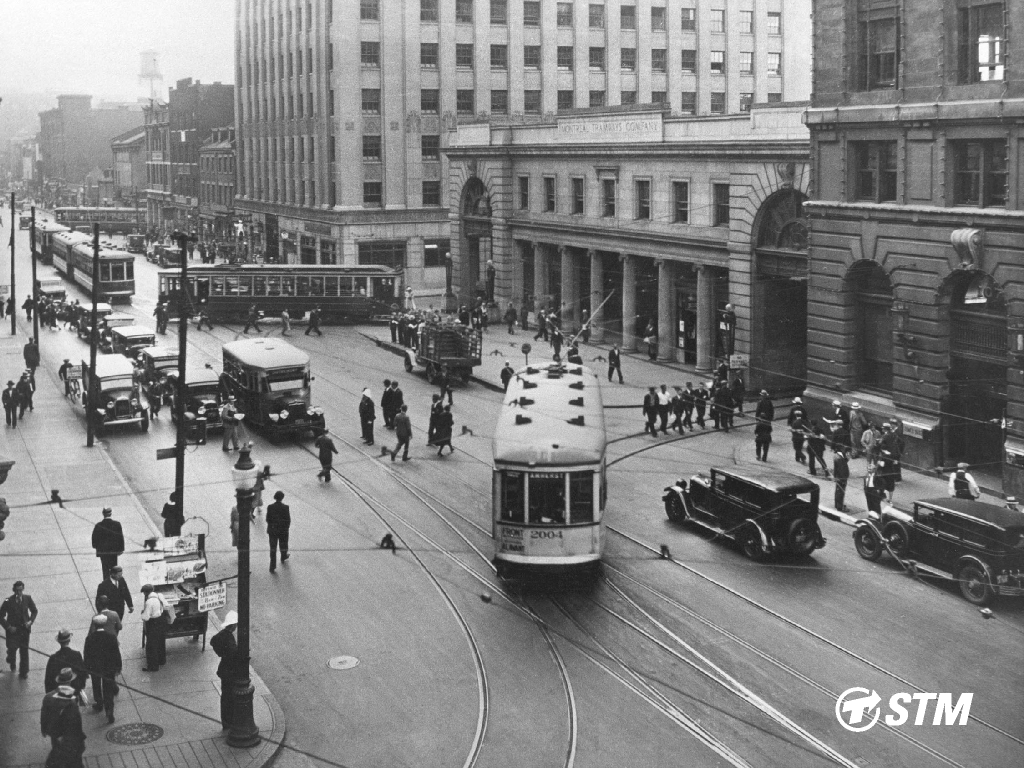
I hate to say it but I end up having to prove that trams can indeed operate effectively in Montréal. I can’t prove that it works technologically – I don’t need to – I can prove it historically. And historically speaking, the technology used for our tram system back before 1959 pales in comparison to the technology we’ve developed here at home. Don’t forget, Bombardier is a world leader in tram design, yet we don’t even have a local example to demonstrate. Kind of pathetic no?
The building above was once the HQ of the Montreal Tramways Company (MTC), predecessor to today’s STM. It has since been integrated into the Palais-des-Congrés, and by this I mean effectively all that remains is the facade and some choice interior details. It’s lost its function.

Here we can see the Tramways Building and Craig Street Terminus – the Berri-UQAM of its day, it once served 14 tram lines directly into the heart of the financial district. Montreal had a tram for about 100 years up until 1959 when the MTC replaced the entire tram network with GMC buses. read all about the Great American Streetcar Scandal here, our tram met it’s fate for the same reason. But it wasn’t just that new buses were introduced, its that the tram network and infrastructure was destroyed in the process, so it couldn’t be used again. This is the travesty.
Trams were the backbone of the City of Montréal’s public transit network for almost a century. They operated year-round in all conditions. They climbed our steep hills and plowed through the snow. All the natural elements you may think might interrupt service on a tram line were considerably more problematic in the past – even as recently as the late 1950s Montréal’s snow-clearing capabilities were still severely limited. Despite this, the tram functioned flawlessly and effectively. While there are certainly gradients too steep for trams to climb in our city, they are almost by there very definition useless and wouldn’t be involved in a tram-route scheme. Consider that both the Camilien-Houde Parkway and Cote-des-Neiges Road once had tram lines operating on them.
Another concern is unsightly overheard wires – there are intersections in Toronto that seem to have massive cyber-punk esque spider-webs overhead! To my knowledge, there are tram designs which draw power from underground sources, and I would advocate for that type to avoid overhead clutter. Either way, in our day and age there are few even remotely compelling arguments against tramways development.
Consider this map and ask yourself how you might design a new tram network for the city and outlying regions. Consider that in 1941, the map above effectively was both city and outlying regions, including first and second ring suburbs. It seems as if the public transit scheme of 1941 was considerably more complete, more wide-reaching, than the model we have today which barely covers the entire island. The STM currently has a fleet of 1,600 buses. Imagine how much farther the STM could reach into the Metropolitan region if it constructed a tramway system to serve the intermediate-urban region between the Métro-served downtown core and the bus-served suburbs.
On a final note, though the STM has been failing at drawing ridership onto the 515, which is supposed to emulate a planned tram route, we can’t ignore the novelty of a new transit system. In other words, people who don’t like the bus or Métro – for whatever reason – may prefer to take the tram. It’ll find a clique of public transit users, and doubtless encourage new riders to commit to public transit. Most importantly, a new tram system, on certain streets, may be more efficient if the tram didn’t have to share the road with regular automobile traffic. In other words, what if we re-designed major urban thoroughfares to be pedestrian/bike/tram only? I can imagine the perennial call to make Ste-Catherine’s a pedestrian mall would gain more traction if high-capacity trams ran down its centre.
What can I say? Shouldn’t this be a major local political issue? I’d like to see an election where at least one party had a sustainable tram-development plan, especially one financed by the city directly, so we’re not sitting around playing with ourselves while we wait for federal or provincial grants. What do you think of the state of our public transit system?



(Hey! That’s the map I scanned!!! :) :) :) — just noticed)
Building the Métro when Montréal has had a very good streetcar system was a big mistake.
Here is my take on what should have been done with streetcars instead of building the Métro:
http://emdx.org/rail/metro/pasDeMetro.php
Projet Montréal has huge plans for a Tram line for 2017. They want it to be the federating project of the 375th anniversary of Montreal.
http://www.projetmontreal.org/communique/35